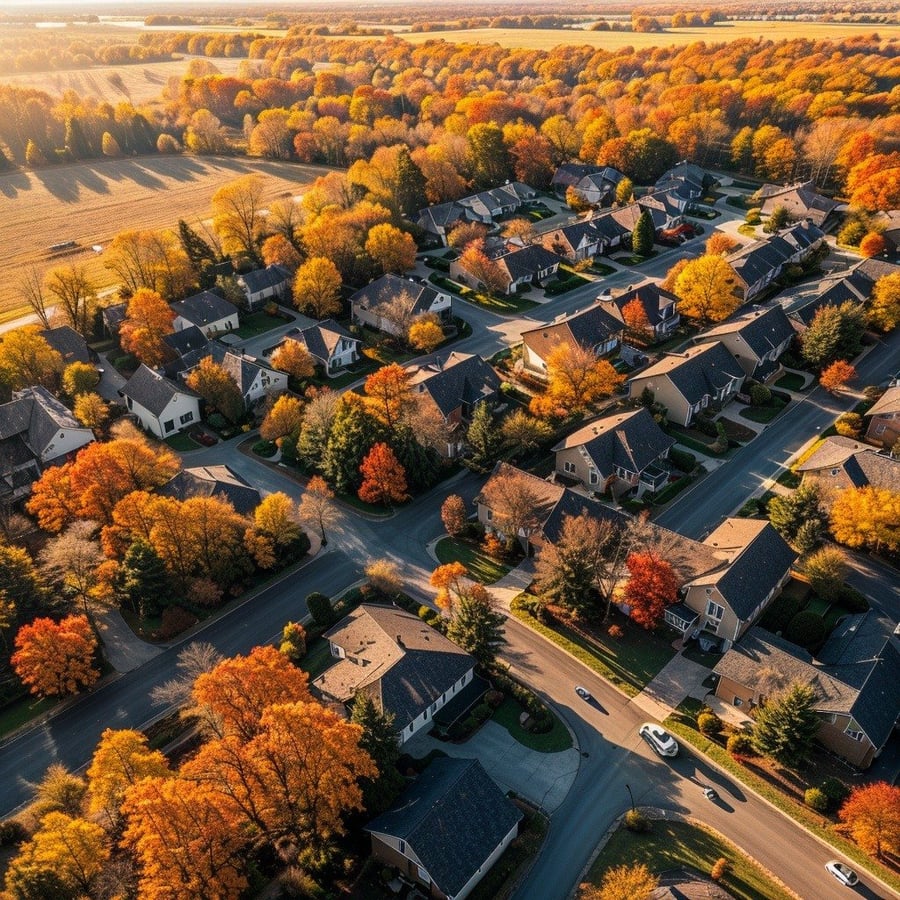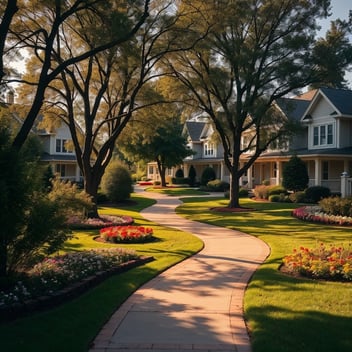Long-Term Landscape Planning for HOAs: A Comprehensive Guide

Introduction: The Foundation of Community Excellence
After spending 25 years transforming community landscapes across Long Island, I've learned that successful HOA landscaping isn't just about maintaining curb appeal – it's about creating a living legacy that enhances property values and builds community pride. As a landscape architect who's guided numerous HOA boards through their landscape planning journey, I can tell you that the most successful communities are those that think long-term.
Long-term landscape planning for HOAs is more than just deciding where to plant next season's flowers. It's a strategic approach that considers everything from seasonal transitions to sustainable practices, from budget optimization to resident satisfaction. In this comprehensive guide, I'll share the essential elements of creating a landscape plan that will serve your community for years to come.
Understanding the Scope of Long-Term HOA Landscaping
Before diving into the specifics, it's crucial to understand that comprehensive HOA landscaping encompasses multiple components that need to work together harmoniously. Having worked with communities of various sizes, I've found that successful long-term plans typically address:
- Core Infrastructure Planning: This involves assessing and planning for major landscape elements that form the backbone of your community's outdoor spaces. This includes irrigation systems, hardscaping elements, tree placement, and soil management strategies. For example, when I helped redesign a 200-unit community in Suffolk County, we created a 10-year tree succession plan to gradually replace aging trees while maintaining consistent shade coverage.
- Seasonal Maintenance Schedules: A well-structured maintenance calendar is essential for keeping your landscape looking its best year-round. This goes beyond basic mowing and pruning to include specialized care for different plant varieties, snow removal planning, and seasonal color rotations.
- Sustainability Initiatives: Modern HOA landscapes need to balance beauty with environmental responsibility. This includes implementing water conservation measures, choosing native plants, and adopting eco-friendly maintenance practices. I've seen communities reduce their water consumption by up to 30% through smart irrigation systems and proper plant selection.
- Budget Allocation and Resource Management: Long-term success requires careful financial planning. This includes setting aside reserves for major projects, planning for regular maintenance, and budgeting for unexpected issues like storm damage or disease control.
Key Components of a Successful Long-Term Landscape Plan
Based on my experience working with successful HOA communities, here are the essential elements that should be included in your long-term landscape plan:
1. Comprehensive Site Analysis
- Environmental Assessment: Understanding your site's specific conditions is crucial for long-term success. This includes analyzing soil types, sun exposure patterns, and microclimates within your community. For instance, when I worked with a coastal HOA in Long Island, we discovered significant variations in soil salinity that required different plant selections for different areas.
- Infrastructure Evaluation: Regular assessment of existing landscape infrastructure helps prevent costly emergencies. This includes evaluating irrigation systems, retaining walls, drainage systems, and hardscaping elements. I always recommend documenting the age and condition of these components to plan for future replacements or upgrades.
- Usage Pattern Analysis: Understanding how residents use different areas of the community helps inform design decisions. For example, one community I worked with redesigned their common areas based on resident surveys, resulting in more functional spaces that better served the community's needs.
2. Plant Selection and Management Strategy
Choosing the right plants is fundamental to your landscape's long-term success. Here's what to consider:
- Native Plant Integration: Native plants are crucial for sustainable landscaping. They're adapted to local conditions, require less maintenance, and support local wildlife. I've helped numerous HOAs transition to native plant varieties, resulting in reduced maintenance costs and improved landscape resilience.
- Succession Planning: Plants have different lifespans, and planning for their eventual replacement is crucial. This includes creating a timeline for replacing aging plants and establishing a diverse age structure in your landscape to maintain consistent coverage.
- Seasonal Interest Planning: Your landscape should look appealing year-round. This means selecting plants that provide interest in different seasons through flowers, foliage, berries, or bark. I recommend creating a detailed seasonal color program that ensures visual interest throughout the year.
3. Maintenance and Care Protocols
- Scheduled Maintenance Programs: Establishing detailed maintenance schedules is crucial for keeping your landscape looking its best. This includes regular tasks like mowing and pruning, as well as specialized care like aeration, fertilization, and pest management. I always emphasize the importance of preventive maintenance – it's more cost-effective than dealing with problems after they develop.
- Emergency Response Plans: Having protocols in place for handling unexpected issues like storm damage, disease outbreaks, or irrigation failures is essential. This includes maintaining relationships with reliable service providers and having clear communication channels for residents to report problems.
- Quality Control Measures: Implementing systems to monitor and maintain landscape quality ensures consistent results. This might include regular inspections, photo documentation, and performance metrics for landscape contractors.
Implementation Strategies for Long-Term Success
Having a great plan is only the first step. Success lies in effective implementation:
1. Phased Implementation Approach
- Priority Setting: Not everything can (or should) be done at once. Start by identifying high-priority areas that need immediate attention while planning for longer-term projects. When I worked with a large HOA in Nassau County, we created a five-year implementation plan that prioritized critical infrastructure improvements before moving on to aesthetic enhancements.
- Budget Management: Breaking down large projects into manageable phases helps spread costs over time while maintaining consistent progress. This approach also allows for adjustments based on actual costs and results from earlier phases.
- Community Impact Management: Phasing helps minimize disruption to residents while maintaining property values throughout the implementation process. It's important to communicate the timeline and expected impacts to residents to maintain their support.
2. Financial Planning and Resource Allocation
- Budget Development: Create comprehensive budgets that account for both routine maintenance and long-term improvements. Include contingency funds for unexpected issues and factor in inflation for multi-year projects. I typically recommend setting aside 10-15% of the landscape budget for unexpected expenses.
- Cost-Benefit Analysis: Evaluate the return on investment for various landscape improvements. This might include reduced maintenance costs, increased property values, or improved resident satisfaction. For example, investing in smart irrigation systems often pays for itself through reduced water usage within 2-3 years.
- Resource Optimization: Make the most of available resources by timing projects appropriately and bundling similar work for efficiency. This includes coordinating with other planned community improvements to minimize disruption and maximize cost-effectiveness.
3. Community Engagement and Communication
- Stakeholder Input: Engage residents in the planning process through surveys, meetings, and regular updates. Their input can help identify priorities and potential issues while building support for the plan. I've found that communities with strong resident engagement typically have more successful landscape programs.
- Educational Programs: Develop programs to help residents understand and appreciate the landscape plan. This might include workshops, newsletters, or guided walks highlighting different aspects of the landscape. Education helps build support for maintenance practices and landscape choices.
- Progress Communication: Regular updates about landscape projects help maintain community support and understanding. This includes sharing successes, explaining challenges, and providing timelines for upcoming work.
Monitoring and Adaptation
Long-term success requires ongoing monitoring and adaptation:
1. Performance Metrics and Evaluation
- Regular Assessments: Establish clear metrics for evaluating landscape performance and conduct regular assessments. This includes monitoring plant health, maintenance quality, and resource usage. Document these assessments with photos and detailed notes to track progress over time.
- Cost Tracking: Monitor expenses against budgets and track the cost-effectiveness of different landscape elements and maintenance practices. This data helps inform future planning and budgeting decisions.
- Resident Satisfaction: Regularly gather feedback from residents about the landscape through surveys and direct communication. Use this feedback to identify areas for improvement and adjust plans as needed.
2. Plan Adaptation and Updates
- Regular Review and Updates: Review and update the landscape plan annually to address changing conditions, new challenges, or opportunities. This might include adjusting plant selections based on performance, modifying maintenance practices, or incorporating new sustainable technologies.
- Climate Adaptation: Consider how changing climate patterns might affect your landscape and plan accordingly. This might include selecting more drought-tolerant plants or improving drainage systems to handle increased rainfall.
- Technology Integration: Stay informed about new landscape technologies and practices that could benefit your community. This might include smart irrigation systems, sustainable maintenance practices, or new plant varieties.
Conclusion: Building a Lasting Legacy
Creating and implementing a long-term landscape plan for your HOA is a significant undertaking, but the benefits far outweigh the challenges. A well-planned and properly maintained landscape not only enhances property values but also creates a sense of pride and community among residents.
Remember, successful long-term landscape planning is an ongoing process that requires commitment, flexibility, and regular communication with all stakeholders. By following the guidelines and strategies outlined in this guide, you'll be well-equipped to create and maintain a landscape that will serve your community for years to come.
If you're ready to start developing or improving your HOA's long-term landscape plan, our team of experts is here to help. We understand the unique challenges and opportunities of HOA landscaping and can help you create a plan that meets your community's specific needs and goals.



